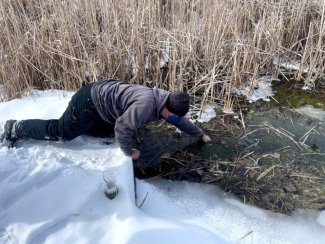
Visit Blue Heron Reserve near Vickery, Ohio, along the Sandusky Bay, and you’ll rapidly realize how dependent plants, animals and humans are to this varied but vulnerable habitat. On a warm spring day, you may be lucky enough to see an endangered Kirtland warbler, with its striking chartreuse belly, enjoying a stopover on its way from the Bahamas to central Michigan. If wild lupine emerge, you could encounter another endangered species: the Karner blue butterfly, which, as a caterpillar, only feasts on the leaves of this beautiful plant. Eastern prairie fringed orchid, protected as a threatened species, is a striking lacy flower that blooms during the summer and can thrive in wetlands that the preserve supports.
Naturally, all species found at Blue Heron Reserve and the overall health of the area itself collectively serve as a bellwether to environmental conditions that affect the people who live nearby and who visit.
Enter Ohio Northern University freshwater ecology students and faculty, who recently began collaborating with the Sandusky County Park District on the restoration of a particular wetland where several invasive species are encroaching. Called a fen, this patch of land at the northeast corner of Sandusky County has water located about 10 inches below its surface. Instead of being swampy, like a bog, the fen’s rich peat can hold plenty of weight while floating atop an aquifer; if you jump on it, the surface will wiggle, according to park district Program Supervisor Deb Nofzinger ‘91.
Along with serving as a “biological supermarket” (as the EPA calls wetlands) and as a shelter site to a wide variety of plant and animal species, fens “are important sites of groundwater discharge and are good indicators of shallow aquifers,” says the U.S. Forest Service. Additionally, wetlands like this one can help with flood control, mitigate soil erosion, recycle nutrients and trap atmospheric carbon dioxide, the latter of which means they help moderate global climate conditions.
“Protecting wetlands can protect our safety and welfare,” the EPA emphasizes.
Fens take thousands of years to form. Records of Blue Heron Reserve’s fen date back to the 1800s. Wetlands such as fens are continuing to disappear because of human activity. Park district personnel believe the approximately 7-acre patch of land that students, faculty and naturalists are restoring was once used as a pasture for livestock. This fen’s largest threat is now non-native plant species that are muscling out vegetation that traditionally nourishes and shelters animals like the Kirtland’s warbler.
This spring semester, ONU Environmental and Field Biology (ENFB) students, under the supervision of biology professors Katherine Krynak, Ph.D., Leslie Riley, Ph.D. , Ken Oswald, Ph.D., and Bob Verb, Ph.D., have begun preliminary work at the fen to determine what’s there so that a comprehensive restorative course of action can be developed and implemented. In February, the 11 who are enrolled in the freshwater ecology class braved the cold and snow to tour and collect samples.
“Students will be working with Debbie on videos that the park district will use to educate the community about the fen’s importance, biodiversity and our collaborative restoration efforts,” Krynak says. “This will serve as a community service component of their course.”
One student will also take part in an internship this summer to further revitalize the fen and help educate the public about it. Nofzinger said work will include delineating fen boundaries, testing soil acidity, conducting fish surveys, and studying existing microbial, algal and macroinvertebrate surveys. They will also have the opportunity to conduct historical research and develop public educational programs and instructional materials. Partnership organizers plan to offer this summer internship in subsequent years, given that fen restoration will also take years to complete.
“Most fen environments have been destroyed,” said Verb. “The fact that this one is still in a natural state is remarkable. That will make the restoration process easier.”
“Fens are important wetlands in dire need of protection and restoration here in Ohio. Therefore, this is a wonderful opportunity for our students to contribute to significant ecological restoration in the region,” Krynak says.
Verb, who directs the University’s ENFB program, has immersed himself in plant restoration research for this project. Invasive or problematic species such as phragmites and giant ragweed are rapidly displacing natives such as swamp milkweed, shrubby cinquefoil and Virginia mountain mint. The soil will be tested for seed varieties and replanting of original vegetation will occur after invasives are removed.
Nofzinger characterizes this project with ONU as “fantastic.”
“I’m really excited about it. This is one of the properties that’s sort of been on the (park district’s) back burner for a while,” says Nofzinger. “This work will bring it to the forefront. We’re hoping to get to the point where people can see what a fen is and appreciate it. The opportunities at this property are limitless.”
The fen restoration project reflects a natural progression of shared professionalism and friendship. Krynak and Nofzinger’s years-long friendship has resulted in Krynak conducting frog research and presentations where Nofzinger has worked, and in Nofzinger teaching ONU students about naturalist interpretation for public enrichment; Nofzinger is certified by the National Association of Interpretation, a professional organization dedicated to advancing the profession of heritage interpretation. She also serves on ONU’s ENFB advisory board.
One more advantage that organizers hope this restoration project offers: the opportunity for the public to better appreciate what nature has to offer. Blue Heron Reserve, which is part of the Lake Erie Birding Trail, is, after all, a prime scenic location that exemplifies nature’s diversity, fragility and wonder.
“We want people to realize there’s cool stuff up by Lake Erie if you just look around. Ohio has a lot to offer. There are lots of habitats and ecosystems,” Nofzinger notes.